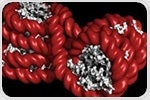
|
|
|
| |

|
|
| |
The latest genomics news from News Medical |
|
|
|
 | | |
 Streamlining NGS library preparation with effortless automation Streamlining NGS library preparation with effortless automation
Labs have reached the limit of manual library prep. Automation needs to adapt to existing workflows while delivering consistent, reproducible results. See how Tecan’s Veya® enables accurate pipetting and consistent deck setup, minimizing variability across batches, users and sites.
| |
|
|
| |  | | | __639011213890486899_multisizecolor_150_custom.jpg) New Houston Methodist research has revealed that a protein associated with neurodegenerative diseases such as dementia and amyotrophic lateral sclerosis (ALS) also plays a role in regulating DNA mismatch repair, a process essential for replicating genetic information and cell health. New Houston Methodist research has revealed that a protein associated with neurodegenerative diseases such as dementia and amyotrophic lateral sclerosis (ALS) also plays a role in regulating DNA mismatch repair, a process essential for replicating genetic information and cell health. | | | | |  A previously unknown type of DNA damage in the mitochondria, the tiny power plants inside our cells, could shed light on how our bodies sense and respond to stress. A previously unknown type of DNA damage in the mitochondria, the tiny power plants inside our cells, could shed light on how our bodies sense and respond to stress. | | | | |  In a 15-patient, Phase 1 one, first-in-human trial, a one-time, CRISPR-Cas9 gene-editing therapy safely reduced LDL cholesterol and triglycerides in people with difficult-to-treat lipid disorders, according to a preliminary late-breaking science presentation today at the American Heart Association's Scientific Sessions 2025. In a 15-patient, Phase 1 one, first-in-human trial, a one-time, CRISPR-Cas9 gene-editing therapy safely reduced LDL cholesterol and triglycerides in people with difficult-to-treat lipid disorders, according to a preliminary late-breaking science presentation today at the American Heart Association's Scientific Sessions 2025. | | | | |  Alzheimer's disease (AD) is a devastating cause of memory loss and cognitive decline, for which no curative treatment is available. Alzheimer's disease (AD) is a devastating cause of memory loss and cognitive decline, for which no curative treatment is available. | | | | |  A groundbreaking new treatment using genome-edited immune cells, developed by scientists at UCL (University College London) and Great Ormond Street Hospital (GOSH), has shown promising results in helping children and adults fight a rare and aggressive form of blood cancer called T-cell acute lymphoblastic leukemia (T-ALL). A groundbreaking new treatment using genome-edited immune cells, developed by scientists at UCL (University College London) and Great Ormond Street Hospital (GOSH), has shown promising results in helping children and adults fight a rare and aggressive form of blood cancer called T-cell acute lymphoblastic leukemia (T-ALL). | | | | |  Cedars-Sinai scientists have developed an experimental drug that repairs DNA and serves as a prototype for a new class of medications that fix tissue damage caused by heart attack, inflammatory disease or other conditions. Cedars-Sinai scientists have developed an experimental drug that repairs DNA and serves as a prototype for a new class of medications that fix tissue damage caused by heart attack, inflammatory disease or other conditions. | | | | |  All the cells in an organism have the exact same genetic sequence. What differs across cell types is their epigenetics-meticulously placed chemical tags that influence which genes are expressed in each cell. All the cells in an organism have the exact same genetic sequence. What differs across cell types is their epigenetics-meticulously placed chemical tags that influence which genes are expressed in each cell. | |
|
|
|  | | | How would you rate today's newsletter?
| |
|
|
|  | | |
 |
Stay updated with the latest in health and medical news! Follow News‑Medical.net on Google News for real‑time updates. Click here to follow us now. |
| |
|
|
|
|
|
|
|